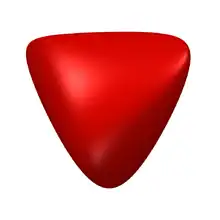Spectrahedron
In convex geometry, a spectrahedron is a shape that can be represented as a linear matrix inequality. Alternatively, the set of n × n positive semidefinite matrices forms a convex cone in Rn × n, and a spectrahedron is a shape that can be formed by intersecting this cone with a linear affine subspace.

Spectrahedra are the feasible regions of semidefinite programs.[1] The images of spectrahedra under linear or affine transformations are called projected spectrahedra or spectrahedral shadows. Every spectrahedral shadow is a convex set that is also semialgebraic, but the converse (conjectured to be true until 2017) is false.[2]
An example of a spectrahedron is the spectraplex, defined as
where is the set of n × n positive semidefinite matrices and is the trace of the matrix .[3] The spectraplex is a compact set, and can be thought of as the "semidefinite" analog of the simplex.
See also
- N-ellipse - a special case of spectrahedra.
References
- Ramana, Motakuri; Goldman, A. J. (1995), "Some geometric results in semidefinite programming", Journal of Global Optimization, 7 (1): 33–50, CiteSeerX 10.1.1.44.1804, doi:10.1007/BF01100204.
- Scheiderer, C. (2018-01-01). "Spectrahedral Shadows". SIAM Journal on Applied Algebra and Geometry. 2: 26–44. doi:10.1137/17m1118981.
- Gärtner, Bernd; Matousek, Jiri (2012). Approximation Algorithms and Semidefinite Programming. Springer Science and Business Media. pp. 76. ISBN 978-3642220159.
